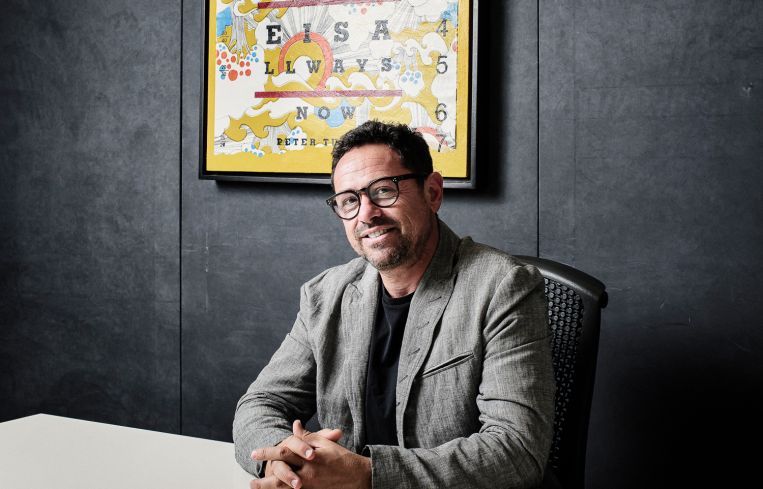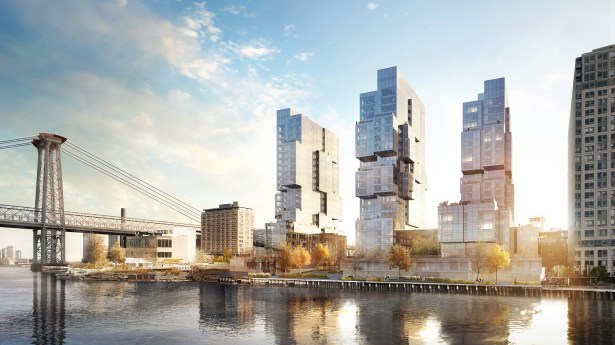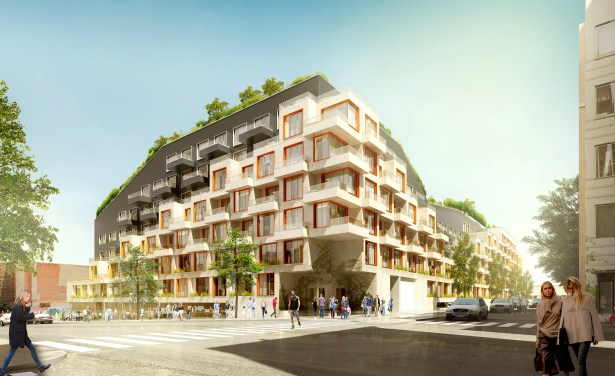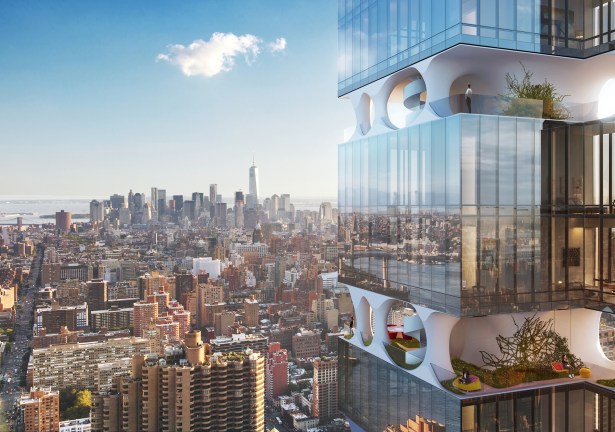ODA’s Eran Chen on Eliot Spitzer, Gentrification and Those Crazy “Floating Gardens”
By Rey Mashayekhi May 10, 2017 10:30 am
reprints
ODA New York’s offices take up a full floor at 250 Park Avenue South, just a couple blocks north of Union Square. On a recent afternoon, the lofty space was abuzz with activity as the firm’s 80-something staff of architects and designers shuffled between desks, surrounded by dozens of renderings and scale models dispersed throughout the room.
This is where Eran Chen, the 46-year-old founder and executive director of ODA, has built one of New York’s most talked-about architectural firms. The Israel native (the Hebrew pronunciation is closer to “Hen” than “Chen”)—who says he was drawn to his field by a natural interest in “psychology, sociology and human interactions”—got his first professional assignment designing a McDonald’s while he was still at Bezalel Academy of Arts and Design in Jerusalem. By the time he graduated, he had helped design 35 separate McDonald’s across Israel.
Chen eventually made his way to New York, landing a job at Perkins Eastman in 2000. Since starting his own firm in 2007 alongside former Perkins colleague P. Christian Bailey (the pair would later bring in Perkins alum Ryoko Okada as a principal and director of interior architecture and design), Chen has overseen the design of 13 completed buildings around New York City, plus more than 20 presently under construction and around 15 that are currently in the design phase.
While ODA—which stands for Office for Design and Architecture—has predominantly worked on residential projects to date, the firm has steadily increased its exposure to office and hospitality development. What’s more, Chen’s growing reputation has helped ODA gain a foothold with projects around the U.S. and Europe.
With ODA now helming some of the New York’s most notable new developments—including Spitzer Enterprises’ sprawling residential complex at 420 Kent Avenue on the Williamsburg waterfront and two major rental developments on the former Rheingold Brewery site in the Bushwick area of Brooklyn—Chen’s influence on the cityscape is only due to expand. He sat down with Commercial Observer to discuss those projects and more.
Given the scale, ambition and pace of the projects you’re currently working on, what’s the secret?
I don’t necessarily think we do more with 80 people than others are doing with 80 people. This is a very energetic, young office. We work around the clock. If you come back tonight at 9, 10 o’clock, it’ll still be humming. It’s a demanding field; you’ve got to be passionate about it, and you’ve got to love it.
Your first job as an architect in New York was at Perkins Eastman. Can you talk about how you got that job and how it helped launch your career?
I came to New York like any other immigrant: I was looking for a job. I had a resume and a portfolio, and I went door to door. The funniest story is that I was invited to an interview [with an architecture firm] in New Jersey. I didn’t want to work in New Jersey, but I thought, I’ll give it a shot, what’s the big deal? I was so unoriented at the time that I took a cab, and it was like an hour-long drive into the heart of New Jersey that cost me like $150—and I was broke at the time.
So I got there and met this really nice guy, in an office with maybe 10 people. And he said, “You’re extremely talented. How much are you looking to make?” I said about $50,000 a year. He said, “We don’t pay that kind of money here. But, my best friend from school is Brad Perkins, and he owns this firm in the city. Let me call him.” I interviewed with Brad, and he hired me immediately. I was just glad to land a job, to be honest.
My first project at Perkins was no other place but Israel. Perkins is considered to be an expert in health care, and they were invited to design this hospital in Tel Aviv. So they put me on the team, and very quickly I become the team leader and lead designer. I was the only Hebrew speaker, I guess.

From what Eliot Spitzer has said publicly, it seems like he chose you for Spitzer Enterprises’ 420 Kent Avenue because he thought you’d bring a unique approach. That appears evident through the towers’ distinct, geometric design.
I think it’s fair to say that we have different expectations from our buildings than usual. Part of it is because so many parts of our lives that used to be in public spaces, like our streets and parks, have been taken away from us by density. I always come back to my memories as a child; I lived in a big city, and the apartment building was only a small part of our livelihood because we lived in the streets, we lived in the park next door, there were communal spaces. The apartment I lived in, there was nothing special about it architecturally, but it was complemented by a lot of urban support. What happened through the years—and New York City is such a great example—is that we lost a lot of those qualities. We expect to bring back some of those qualities to the buildings themselves.
When Eliot and I met, it was clear that there is something about the building along the front of the East River that is very generic right now, partially because the neighborhoods had been undefined—and to be fair, they are now much more defined and have more character—and partially because that was the expectation. But the potential of living right on the East River and the openness of the views that you get are insane. So we laid out the floor plan in a way where every apartment, from a studio to a three-bedroom, would have a corner living room with a view.
What was your working dynamic with Spitzer like?
Eliot is an extremely intelligent guy, very open and surprisingly knowledgeable about real estate and housing. I say surprisingly because it hasn’t been his field, but he grew up into it—his father was a legendary developer.
It was very easy for us; from our first conversation, we talked about ideas and clicked. There was also a little caveat. I promised him that he would be able to get his approval for 421a [at 420 Kent Avenue before the program expired] even though there was a very short deadline to get [into the ground]. I said, We’ll jump on it and make it happen—it was crazy, because we had to do the whole thing in two months. He said, “If you do it, then I will increase the construction budget by $50 a square foot, because it’s that worth it to me, and we’ll do an amazing building.”
ODA is designing two separate, sizable residential projects for All Year Management and the Rabsky Group on the Rheingold Brewery site in Bushwick. Some people who live in the neighborhood are skeptical about the scale of the developments and fear Bushwick will become like Williamsburg. What was your vision for those projects?
We don’t take lightly the fact that the two biggest projects in Bushwick currently are designed by ODA. Frankly, there’s no doubt that they’re going to transform some of the character of that neighborhood. And that’s a huge responsibility.
Part of the problem that I see with gentrification at large is that it’s inherently bringing totally different typologies of architecture and different groups of people [to neighborhoods] that are taking over the existing ones.
I was taken on a tour of the neighborhood by a son of one of the clients, and I was shocked to understand how deeply he is involved in the life in Bushwick. He knew all the bars, all the galleries, all the cool places to go that I would never know about otherwise. The fact that you can reach those untraditional venues and find untraditional subcultures is partially because of the architecture, which allows for that activity—people with back gardens growing vegetables, wineries and self-makers of furniture. So we thought, How can we implement that in an urban project?
That was the guiding thought there, and the end result [at the All Year project] is a series of five courtyards that are interconnected through what’s typically called amenities—but here, the amenities are really acting as street programming. They open to those gardens, and there’s an in-and-out interaction. Some of them are retail, some are cultural like galleries, some are just typical amenities, and they’re shared by the people in the building but also open to some degree to the general public.
For the Rabsky project, we had similar ideas. But in addition, we thought about the idea of roof gardens. In my mind, roof gardens are always thought of as a secondary or compromised garden to the real one—which is the park. We thought, well, the roofs have a typology that you can control; with a building, you can control the landscape. So we started sculpting that roof in a way that it’s not flat—you have hills and valleys that generate different types of activities.
And because [the roof gardens] are sloped, they intersect with different floors. So if I live on the third floor of the building and not the 13th, I can still go to the end of my corridor and end up at the roof park without going up the elevator. This immediate connection, between every floor of the building and the roof garden, is the main idea here.

You’re also working on an ambitious residential skyscraper for Triangle Assets at 303 East 44th Street in Midtown that features exposed “floating gardens,” occupying gaps within the building itself, hundreds of feet in the air. It seems like a logistical nightmare.
[Laughs] This was sort of an experiment. Slender towers are exactly the opposite form of what ODA and I believe in. Slender towers touch the city in the smallest, most insignificant way but impact the skyline in the most significant way.
When we were approached to design this, the immediate reaction was, What is it that we’re going to do with this? But then came the thought of the advantage of living in the suburbs: Why are people still drawn to that? And partially, it’s the formula of a house with a backyard or a front yard—the idea that you can be in your living room, open the door and the kids can play out in the garden. And that’s something that obviously cannot exist in the city.
But the nice thing about slender, vertical towers is that they have no height limit. So we thought, if we can stretch this building beyond its program, we can create, literally, gaps in the building—and that gap could become, instead of a backyard, a “down-yard” or an “up-yard.” And that would be fascinating, because that could really change our perception of how we can accommodate that kind of experience in cities.
Everybody thought it was a crazy idea in the beginning. First of all, people said, it’s going to count as floor area. Well actually, a covered outdoor space does not count against FAR [or floor area ratio] if it’s more than 67 percent open on all sides—and obviously, if this [space] is open all the way around, it’s not floor area.
Number two, people said, who needs outdoor space at 600, 700 feet in the air? Everything is going to fly off from the wind. This is probably true if you have a balcony or an open roof.
But the fascinating thing about this—which we didn’t know in the beginning and which we learned through testing in wind tunnels—is that when that gap in the building exists that high up, there is air that is captured within the building envelope. And that air, when the wind hits it, kind of diverts the wind to the other side [around the building]. The results were amazing! Because at any given point, even in the worst conditions, the maximum wind speed was 15 miles per hour—the maximum, throughout the year.
That says that if you compare these outdoor spaces at 600 feet in the air to a roof on the seventh floor of a building, it’s exposed to less wind throughout the year than the roof on the seventh floor. Which means that they’re not only beautiful, but they’re usable. We made them 16 feet high so the sun would come through, and we have a buffer zone for dirt so people can plant their own gardens.
The real question is, What’s the added value of this non-FAR area? I made a prediction once—and I still stand behind it—that in like 15 to 20 years, even high-rise apartments with views, without outdoor spaces they’ll be hugely devalued. It’s going to feel like, Why would I ever live in an apartment without properly designed outdoor space?

Despite delays in the renewal of the 421a tax abatement that hindered rental development in New York City, ODA has kept up a pretty active and interesting pipeline.
We’ve been very busy, and we have the ability to choose which projects we want to work on. Also, we’ve been involved in more national and international projects, which we weren’t so much before. New York is still our biggest market, but it’s changing. We’re now active in Boston, Atlanta, D.C., Los Angeles, Pittsburgh, and we’re also doing projects in Rotterdam [in the Netherlands] and London.
As far as your aesthetic and design philosophy, where does it come from and what is it based on?
Look, I think the aesthetic of our design is driven by the ideas that they represent—not the other way around. If we have ideas for housing, you’d see those ideas for housing development throughout our projects, and it might look like they have similar aesthetics. If we were to design for other [building types], the aesthetic might change altogether.
But I would say they all follow the idea of more fragmented, more porous and better functioning buildings—that drives everything we do. The rest is understanding materiality and what’s reasonable to build in what location and making those choices. And beauty—I don’t think beauty is a bad word. I think aesthetics and beauty are extremely important for us in terms of composition, but they come almost as natural things that have to be in every project.
Beyond your own firm, who and what do you see in New York City architecture that you like?
I’m a big fan of Herzog & de Meuron. I think this is an office that has been consistent with their ideas and very diverse in their style, which is something I admire.
What’s happening along the High Line is definitely spectacular, because it feels to some degree like an experiment. The buildings that are being built along the High Line are different in that they’re not facing the street—they’re facing this linear park that acts as a street. That, by itself, forces architects to make different types of decisions.
I think that Brooklyn is now the new frontier in terms of great architecture, more so than Manhattan. A lot of mixed-use conversions and additions in neighborhoods like Williamsburg, Dumbo and even Brooklyn Heights are bringing new typologies that are really great.


